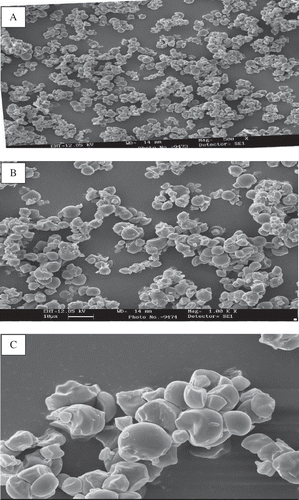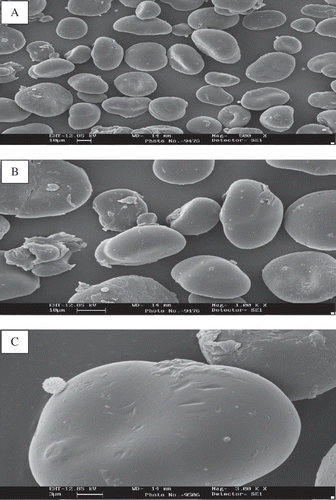Abstract
The effects of annealing (ANN) and heat-moisture treatments (HMT) on the physicochemical and functional properties of Sword bean starches were investigated. The pasting properties differ significantly among the starches, with peak viscosity ranging from 399.17 RVU to 438.33 RVU; however, all the starches exhibited ‘Type C’ class with restricted swelling. The HMT starches had the highest gelatinization temperature, while change in enthalpy of gelatinization, ΔHgel of the native starch, was higher (13.82 J/g) than that of the modified starches (1.39–6.74 J/g). The solubility and swelling power of all the starches increased as the temperature increased. The oil and water absorption capacity of the starches ranges between 3.24–3.91 g/g and 2.42–3.35 g/g, respectively. HMT (at 25 and 30% moisture level) changes the X-ray diffraction pattern of the starch from Type ‘B’ to Type ‘C’. The Scanning electron micrograph results revealed the starch granules with smooth ellipsoids and indentation in their centre, hydrothermal modification showed little effect on the morphology and size of the granules. Hydrothermal modification improved the physicochemical and functional properties of the starch without destroying the granule of the starch.
INTRODUCTION
Starch occurs naturally as water insoluble-granules whose form is characteristics of botanical origin. It is present in most green-leafed plants in various locations: in the seed (cereal and legumes), root and tuber (potato, cassava), in the stem-pitch (sago), in the fruit (banana). Starch consists of two main polysaccharides, amylose and amylopectin. Both polysaccharides are based on chains of α-(1–4) linked D-glucose units, whereas amylose is essentially a linear polymer built up by α-(1–4) linked D-glucose units, amylopectin is a very branched molecule, composed of linear α-(1–4) glucan chains linked together at the α-(1–6) branch points.[Citation1] Starch is basically used in the food industries as thickening agents, colloidal stabilizers, moisture retention, gel-forming agents, binders, coating and glazing agents.[Citation2] Starch also found applications in cosmetic dusting powder, laundry stiffening agent, paper and photographic paper powder, sugar coating in confectionary, and as excipient in the pharmaceutical industries, plastics, paper, textile, etc. The properties of native starch such as viscosity, gel formation, and water binding capacity as well as its adhesion and adhesive power are utilized in industrial applications. These basic properties can be selectively altered through modifications. Chemical, enzymatic, and physical modifications are commonly used, but physical modification (moisture, heat, shear, or radiation) is gradually becoming the preferred method in the industries, because it is considered to be natural material with high safety.
Hydrothermal treatment is a physical modification that involves the modification of starch physicochemical properties without destroying its granular structure. Annealing (ANN) and heat-moisture-treatments (HMT) are two widely used method of hydrothermal modification of starch. ANN of starch involves incubation of starch in water for an extended period, below the gelatinization temperature (To ) and above the glass transition temperature (Tg ) of the starch; while HMT involves incubation of starch granules at low moisture levels (<35% moisture level, w/w), at a temperature above the Tg but below the To for a certain period of time.[Citation1]
HMT causes the evolution of the X-ray pattern from the B- to the A- (or C-) type,[Citation3,Citation4] although no changes in the X-ray pattern was observed after annealing of starch.[Citation5] An increase of the gelatinization temperature range (difference between the onset and conclusion temperature) and a decrease of the gelatinization range as a result of annealing were observed.[Citation3,Citation5,Citation6]. HMT also increases the gelatinization temperature but with broader range.[Citation3,Citation7,Citation8] Starch RVA pasting properties has been reported to have higher onset temperature of viscosity development, a lower peak viscosity, and a higher end viscosity[Citation8–10] after heat-moisture treatment.
Annealing has been reported to cause a reorganization of starch molecules, leading to amylopectin double helices to acquire one more organized configuration[Citation4,Citation11] and this increase provokes the decrease on swelling power and solubilization of starches.[Citation5,Citation7,Citation12] Annealing also leads to elevation and sharpening of the gelatinization range, and causes little solubilization of the α-glucan.[Citation13]
Starch origin plays significant role in the physicochemical properties of starch.[Citation14] Source of starch varies all over the world with about 60% of the world production of starch isolated from corn starch.[Citation15] The growing demand for starch in food and non-food industries, coupled with its increasing cost, has necessitated the sourcing of starch from other lesser-known and underutilized sources such as legumes. One of such is sword bean (Canavalia gladiata) with lots of desirable attributes but little agronomic development since its seeds are not extensively utilized as food due to its toxicity.[Citation16–21] Authors showed previously that acetylation and oxidation of sword bean starch has profound effects on its functional and physicochemical properties.[Citation22] The objective of the present research therefore was to characterize the physicochemical and functional properties and to determine the effect of hydrothermal modifications (ANN and HMT) on the sword bean starch properties. It is hoped that information generated from this study could be used in enhancing the industrial utilization of the starch.
MATERIALS AND METHODS
Starch Isolation
Sword bean cultivated at International Institute for Tropical Agriculture (IITA), Ibadan, Nigeria, was manually dehulled, screened to remove stones and impurities, and then dry milled. The starch (analysis: moisture, 13.14%; crude protein, 0.17%; crude fibre, 0.08; fat, 0.14; ash, 0.87; carbohydrate, 85.60%, pH, 6.55; energy value, 1,437.14 KJ Kg−1; starch yield, 31 g/100) was isolated from the bean flour by the method in our earlier publication.[Citation22]
Hydrothermal Modification of the Starch
The method of Sair[Citation23] was employed for the heat moisture treatment with slight modification. Starch samples were weighed into different glass containers, the starch moisture content was brought to 20, 25, and 30%, respectively. The sealed samples (in glass jars) were heated in an air oven at 100°C for 16 h. After heat treatment, all starches were dried at 45°C to a uniform moisture level (∼10%). The method of Krueger et al.[Citation11] was employed in preparation of annealed starch. The starch was annealed by heating 50 g of starch in excess water at 50°C (the 50°C is less than the glass transition temperature but greater than onset temperature) for 48 h. Samples were centrifuged to remove excess water, washed with acetone, and air-dried.
Pasting Properties
The pasting properties of the starches were determined by using Rapid Visco Analyzer (RVA) model 3-D (Newport Scientific Pty Ltd., Warriewood, Australia). A 13.8% (w/w) starch suspension was prepared by placing 4 g (dry basis) of starch in an aluminum canister, which contained 25 g of distilled water. A programmed heating and cooling cycle was used at constant shear rate, where the sample was equilibrated at 35°C for 2 min, heated to 95°C at a rate of 11.8°C/min, held at 95°C for 2.5 min and cooled to 35°C at the same rate. These tests were done in triplicate. A plot of paste viscosity (PV), in arbitrary RVA units (RVU) versus time was used to determine the cold (initial) viscosity, peak viscosity (PV), temperature at PV (Ptemp), final viscosity (FV), breakdown viscosity (BKD = PV – trough), and total setback viscosity (TSB = FV – trough). The first point at which the viscosity increased at the rate of 1 RVU/s or faster, determined as the onset temperature of gelatinization (Tg) of the starch.
Thermal Properties
The thermal properties of the starches were studied using a differential scanning calorimeter (DSC – Mettler TA 4000, Switzerland). The gelatinization parameters of native and retrograded starch were evaluated by the methods proposed by Ratnayake et al.[Citation24]
Gelatinization Parameters of the Starch
Water (11 μl) was added with a microsyringe to starch (3.0 mg) in the DSC pans, which were then sealed, reweighed and allowed to stand for 2 h at room temperature before DSC analysis to attain an even distribution of water. The scanning temperature range and heating rates were 30–140°C and 10°C/min, respectively. In all measurements, the thermogram was recorded with an empty aluminum pan as the reference. The transition temperatures reported are the onset (To), peak (Tp), and conclusion (Tc). The enthalpy of gelatinization (ΔH) was estimated by integrating the area between the thermogram and a base line under the peak and was expressed in terms of Joules per gram (J/g) of dry starch.
DSC Parameters of Retrograded Starch
A known volume of water (3 μl) was added with a microsyringe to 3.0 mg of the starch in the DSC pans, which were then sealed, reweighed and allowed to stand for 6 h at room temperature for moisture equilibration. The sealed pans were then heated (20–120°C at 10°C/min) to gelatinize the starch. The gelatinized samples were stored at 40°C for 24 h to enhance the propagation of crystallites. Subsequently, the samples were equilibrated at room temperature for 2 h, and then rescanned in the calorimeter from 20–120°C at 10°C/min to measure retrogradation transition temperature and enthalpy.
Hydration Properties
Swelling power and solubility
The determination of the swelling power and solubility of the starches was carried out by using the method of Schoch[Citation25] with slight modification as follow: 1.5 g of the starch sample and 40 ml of water was subject to heating at temperatures of 55, 65, 75, 85, and 95°C. After cooling, the starch slurry was centrifuged at 5000 × g for 30 min. The supernatant was separated and 10 ml was carefully withdrawn to calculate the soluble content. The sediment was weighed to determine the swelling power as a ratio of weight of swollen granules to the weight of dry starch. Results used for calculations were means of triplicate measurements.
Water and oil absorption capacity
Water absorption capacity of the starch was studied as follow; samples (3 g) were dispersed in 25 ml of distilled water and placed in pre-weighed centrifuged tubes. The dispersions were stirred occasionally, held for 30 min, followed by centrifugation for 25 min at 3000 g. The supernatant was decanted, excess moisture was removed by draining for 25 min at 50°C, and sample reweighed.[Citation26] For the determination of oil absorption: Samples (0.5 g) were mixed with 6 ml of corn oil in preweighed centrifuged tubes. The contents were stirred for 1 min with a thin brass wire to disperse the sample in the oil. After a holding period of 30 min, the tubes were centrifuged for 25 min at 3000 g. The separated oil was then removed with a pipette and the tubes were inverted for 25 min to drain the oil prior to weighing.[Citation27] The water and oil absorption capacities were expressed as gram of water or oil bound per gram of the sample on a dry basis.
Gelation properties
Test tubes containing starch suspensions of 2%, 4%, 6%, 8%, 10%, 12%, and 14% (w/v) of material in 5 ml distilled water were heated for 1 h in boiling water followed by rapid cooling under running water. The tubes were further cooled at 4°C for 2 h. Least gelation concentration, LGC is the concentration at which the sample did not fall down or slip when the test tube was inverted.
Wide-angle X-ray diffractometry
Starches for X-ray diffraction measurements were kept in a desiccator (at 25°C) over saturated K2SO4. X-ray diffractograms were obtained with a Rigaku D-Max- 2200 X-ray diffractometer (Rigaku-Denki Co., Tokyo, Japan). The hydrated samples (0.5 g dry basis) were packed tightly into an elliptical aluminum holder. The operating conditions were: target voltage 40 kV, target current 100 mA, aging time 5 min; scanning range 3–35°, scan speed 2.000° min; step time 4.55, divergence slit width 1.00; scatter slit width 1.00 and receiving slit width 0.6.
Morphological properties
Granule morphology of the starches was studied by scanning electron microscopy (SEM). Samples were sputter-coated with Au/Pd using a vacuum evaporator (Ewards, Milano, Italy) and examined using a scanning electron microscope (model 500, Philips, Eindhoven, The Netherlands) at 10 KV accelerating voltage using the secondary electron technique.
RESULTS AND DISCUSSION
Pasting Properties
The pasting properties and curves of the native and modified (HMT and ANN) starches of Sword bean is presented in and (A-E), respectively. The pasting curve obtained is a measure of the viscosity of starch suspension during the heating cycle, which reflects the molecular events occurring in starch granules.
Figure 1 The RVA viscoamylogram of native (SBN), annealed (SAN), and heat-moisture treated (SHT 20; 25; 30) sword bean starches. (Figure provided in color online.)
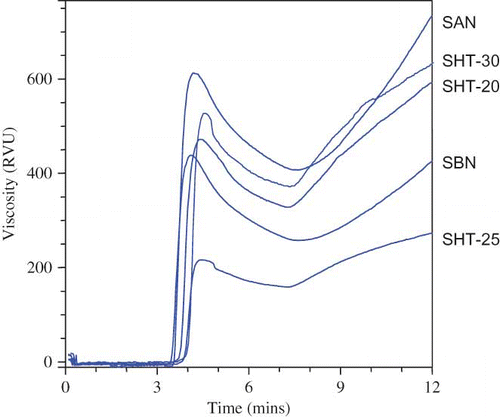
Table 1 Pasting properties of sword bean physically modified starch (on dry basis)
Pasting properties differ significantly among the starches studied. The pasting temperature of the starches ranged from 64.15 to 64.55°C. The native starch (SBN) had the highest peak viscosity (438.33 RVU), while the annealed starch (SAN) had the lowest peak viscosity (399.17 RVU). Annealing treatment was reported to have reduced the peak viscosity of cassava starch samples.[Citation28] According to Ghiasi et al.,[Citation29] increase in viscosity with temperature may be attributed to the removal of water from the exuded amylase by the granules as they swell. Although final viscosity increased upon cooling for all the starches (except SBN), setback (which is the difference between the final and peak viscosity) varied significantly. The increment in the final viscosity upon cooling is due to the aggregation of the amylose molecules, since setback value is the recovery of the viscosity during cooling. Based on Schoch and Maywald[Citation30] classification of starches, all the starches exhibited Type C class with restricted swelling which is characteristic of legumes. There was reduction in the peak viscosity of the physically modified (HMT and ANN) starches to 216.58–399.17 RVU from 438.33 RVU in the native starch (SBN). Similar trend was observed in the Trough Viscosity, Breakdown, Final Viscosity, and Setback, of all the heat-moisture treated starches. These changes of pasting characteristics indicated that starch molecules have some degree of reassociation during hydrothermal treatments. Stute[Citation3] reported similar findings in the changes of pasting properties of heat-moisture-treated potato starch.
Thermal Properties
The gelatinization profile of physically modified (HMT and ANN) Sword bean starch () shows general increase in the gelatinization temperature of the starches, with the HMT starches recording higher temperature range than the annealed (SAN) starch in the following order: SHT-25 > SHT-20 > SHT-30 > SAN > SBN. Similar result was obtained for pigeon pea,[Citation31] wheat, oat, potato and lentil,[Citation4] potato,[Citation32] and varieties of maize starches.[Citation8] Annealing usually leads to elevation of starch gelatinization temperatures and sharpening of the gelatinization range. The enthalpy of gelatinization (ΔH gel) of the native starch (13.82 J/g) was higher than the value obtained for the other starches (1.39–6.74 J/g). ΔH gel reflected primarily the loss of molecular (double-helical) order, however, double-helical and crystalline structures are disrupted in starches during gelatinization.[Citation33] Since ΔH gel is a reflection of the melting of the crystalline zone, the higher value of ΔH gel of the native starch compared to the modified starches, may be an indication of decrease in the crystallinity of the modified starches. The lower degree of gelatinization observed in the SHT-30, when compared with SHT-20 and SHT 25, may be due to acceleration of molecular rearrangement of the starch during heat-moisture treatment at higher moisture level (30%). The reassociation may occur mainly on the amylose in the amorphous regions, which will result in recrystallization, perfection of the small crystalline regions or strong interactions of amylopectin and or amylose.[Citation34]
Table 2 Gelatinisation parameters of Sword bean native and physically modified (HMT & ANN) starches (on dry basis)
The thermal characteristic of retrograded Sword bean native and modified starch (ANN and HMT) is presented in . In the retrogradation study of the Sword bean starch, To, Tp, and Tc, was lower for the HMT starches () than that of the gelatinisation values () of the starch. The narrow melting temperature (Tc--To) range of the HMT starch (0.66–0.94°C) may be an indication of presence of crystals of homogenous quality and similar stability.[Citation24,Citation35] Actually, the rate and extent of amylopectin retrogradation is influenced by its chain length.[Citation36] However, SAN had highest To, Tp, Tc, and ΔH R values with temperature range of 61.59–70.44°C. Krueger et al.,[Citation11] in their studies of maize starches with different amylose content, observed that maize with the highest amylose content had the largest changes in their DSC characteristics; by similar reasoning, the result obtained for SAN may be due to restricted leaching of its amylose content during modification.
Table 3 Retrogradation characteristics of Sword bean native and physically modified starch
Hydration Properties
Swelling power is an indication of the ability of the starch to hydrate under specific cooking conditions. The swelling power of native (SBN), hydrothermally modified (SAN, SHT-20, −25, and −30) sword bean starches measured from 55–95°C at 10°C intervals () shows an increased swelling power of all starches as the temperature increased. The intragranular binding forces of the starches were weakened as a result of increase in temperature, thus facilitating the penetration of water into the crystalline area of the starches with consequential increase in the swelling power of the starches. The swelling profile of the Sword bean starches increased in the following order: SBN > SAN > SHT-30 > SHT-25 ≈ SHT-20. This trend shows a decrease in the swelling power after hydrothermal treatment of the starch. Similar result of decrease in swelling power after ANN and HMT was reported for wheat,[Citation1,Citation4,Citation32] oat and lentil,[Citation37] and rice.[Citation34,Citation37]
Figure 2 Swelling power of native and hydrothermally treated starches of Sword bean (on dry basis). B: Sword bean native starch (SBN); C: Sword bean starch HMT at 20°C (SHT-20); D: Sword bean starch HMT at 25°C (SHT-25); E: Sword bean starch HMT at 30°C (SHT-30); and F: Sword bean annealed starch (SAN).
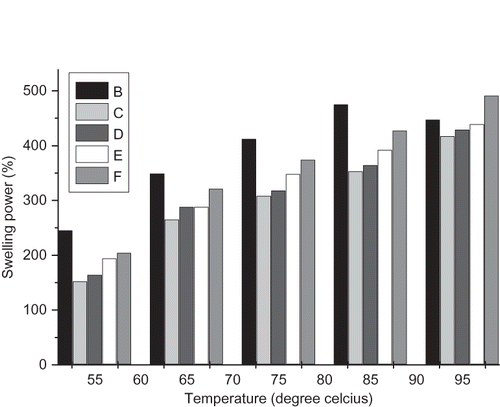
The solubility power of the Sword bean starch at different temperature () shows that there was increase in the solubility of all the starches as the temperature increased in the following order: SHT-30 >> SHT-25 ≈ SHT-20 > SAN > SBN. During heating, starch granules swells and amylose are leached out. The lower solubility power of the annealed starch compared to the HMT starches may be an indication that the interaction between amylose and amylopectin or between amylopectin molecules is increased after annealing than in the HMT starches. Lorenz and Kulp,[Citation7] and Hoover and Vasanthan[Citation4,Citation5,Citation37] also reported decrease in the swelling power and amylose leaching after annealing.
Figure 3 Solubility power of native and hydrothermally treated starches of Sword bean (on dry basis). B: Sword bean native starch (SBN); C: Sword bean starch HMT at 20°C (SHT-20); D: Sword bean starch HMT at 25°C (SHT-25); E: Sword bean starch HMT at 30°C (SHT-30); and F: Sword bean annealed starch (SAN).
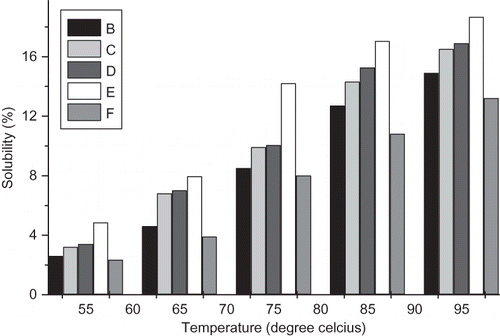
The ability of starch to absorb oil is a measure of the emulsifying potentials of the starch. The oil absorption capacity is also important as it improves the mouth feel and retains flavor.[Citation38] The oil and water absorption capacities of Sword bean starches () were 3.24–3.91 g/g and 2.42–3.35 g/g, respectively. Sathe and Salunkhe[Citation39] reported 2.9 and 2.93 g/g for the Great northern bean starch studied. ANN and HMT did not improve the oil and water absorption capacity of the sword bean starch appreciably. This is probably due to the low level of protein in the starches, since hydrophobic proteins show superior binding of lipids, while non-polar amino acid side chains bind the paraffin chains of fats.
Table 4 Oil and water absorption capacity of Sword bean starches (on dry basis)
The ability of starch to form a gel is a desirable quality in food industries. The least gelation concentration (LGC) of SBN, SAN, SHT-20, SHT-25, and SHT-30, are 10, 8, 8, 6, and 4, % (w/v), respectively (). Schimdt[Citation40] postulates that gelation in legumes flour involves the formation of protein-polysaccharide complex. Gelation properties are influenced by a physical competition for water between protein gelation and starch gelatinization.[Citation41] The modified starches had lower LGC when compared to the native starch (SBN), with the annealed starch having the lowest LGC value (SAN; 4% w/v). This observation may be attributed to the fact that the modified starch is purer than the native starch; hence, the competition for water between protein and starch is greatly reduced in the modified starches.
Table 5 Gelation capacities of Sword bean starches (on dry basis)
Wide-Angle X-ray Diffraction Patterns
The X-ray diffraction pattern of the native Sword bean starch (SBN), annealed (SAN), and heat-moisture-treated starch at 20% (SHT-20), 25% (SHT-25), and 30% (SHT-30) moisture is presented in . Sword bean native starch (SBN) and SHT-20 exhibited the Type ‘B’ X-ray pattern with strong peaks at 17.2 and 17.1 Å, respectively. The annealed starch (SAN) also exhibited type ‘B’ X-ray pattern with strong peaks at 15.1, 17.15, and 23.35 Å. SHT-25 exhibited the Type ‘C’ X-ray pattern with strong peaks at 15.35, 17.3, and 23.50 Å, and weak peak at 10.05 and 20.25 Å. Similarly, SHT 30 also had the Type ‘C’ X-ray pattern with strong peaks at 15.4, 17.3, and 23.50 Å, with weak peaks at 10.00 and 20.40 Å. Gunaratne and Hoover[Citation42] postulates that change in X-ray pattern from ‘B’ to ‘C’ could be attributed to (a) dehydration (vaporization of the 36 water molecule in the central channel of the ‘B’ unit cell), and (b) movement of a pair double helices into the central channel (that was originally occupied by the vaporized water molecules). Double helical movement during heat-moisture-treatment could disrupt starch crystallites and/or change crystallite orientation, hence the change observed after heat-moisture-treatment. This observation could be responsible for the changes in the crystallinity of the starch after heat-moisture treatment. The Type ‘A’ X-ray pattern (shown mainly by cereal starches) and ‘B’ patterns represents the true crystalline forms of starch, but the Type ‘C’ patterns is believe to be a superposition of the ‘A’ and ‘B’ patterns.[Citation43] This observation was further corroborated by Gidley.[Citation44] who suggested that the Type ‘C’ pattern is not a true crystalline polymorph but rather a mixture of ‘A’ and ‘B’ polymorphs. A fourth pattern, the ‘V’ pattern, arises from complexes formed by amylose with a variety of polar organic molecules.[Citation45,Citation46]
Figure 4 Wide-angle X-ray diffraction pattern of native Sword bean (SBN), Annealed (SAN), Heat-Moisture Treated starches at 20% (SHT-20), 25% (SHT-25), and 30 % (SHT- 30) moisture. SBN: Sword bean native starch; SHT-20: Sword bean starch HMT at 20% moisture; SHT-25: Sword bean starch HMT at 25% moisture; SHT-30: Sword bean starch HMT at 30% moisture; and SAN: Sword bean annealed starch. (Figure provided in color online.)
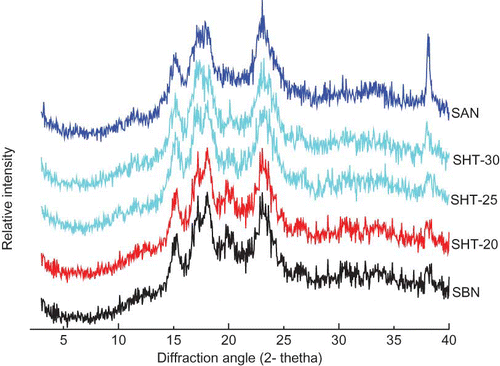
Morphological Properties
Scanning electron micrographs (SEM) was used to observe the shape and surface characteristics of the starches; for comparisons of size and morphology, the micrographs were obtained at 500, 1000, 3000 × magnification, these pictures are presented in . Sword bean native starch (,B) has smooth ellipsoids and indentation in their center. The surface of individual granules photographed at 3000 × magnification appears smooth (). Hydrothermal treatment of Sword bean starch had no appreciable effect on the morphology and size of the granules (), this is an indication that hydrothermal treatments only modify the physicochemical properties of starches without destroying the granular structures. Perera et al.,[Citation47] Hoover and Manuel,[Citation8] Hoover and Vasanthan,[Citation37] and Stute,[Citation3] also observed no change in the morphology of starch after hydrothermal treatment. There was mark-like scratching on the few of the annealed starch (SAN) granules when viewed at 3000 × magnification (). Kawabata et al.[Citation48] reported the formation of cracks on the surface of HMT treated maize and potato starches, with a hollow inside the granule. Close observation of SHT-20 granules () reveal fractures at edge of the surface. Varriano- Marston et al.,[Citation49] pointed out that the preparation method can affect morphology of starch granules. There was chipping away of the smooth surface of the granules after HMT at 25% (SHT-25; ), while the granules of the SHT-30 appear like a cluster () at 3000 × magnification.
Figure 5 Scanning electron micrograph of Sword bean native starch (SBN) at 500 (A), 1000 (B), and 3000 × magnification.

Figure 6 Scanning electron micrograph of heat-moisture (20%) treated starch of Sword bean (SHT-20) at 500 (A), 1000 (B), and 3000 (C) × magnification.
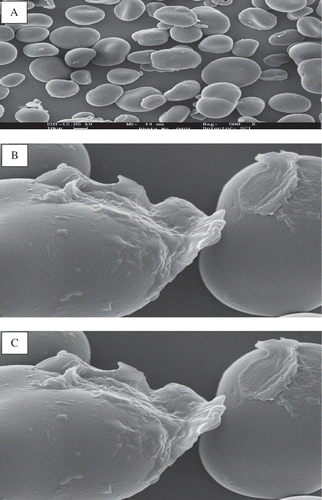
Figure 7 Scanning electron micrograph of heat-moisture (25%) treated starch of Sword bean (SHT-25) at 500 (A), 1000 (B), and 3000 (C) × magnification.
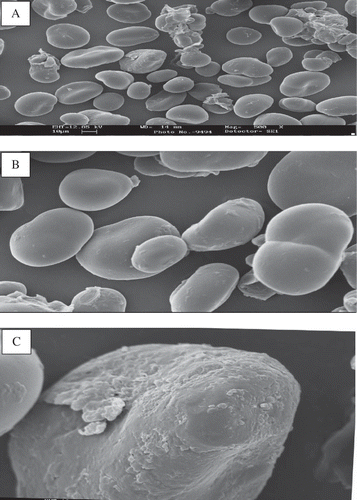
CONCLUSION
Hydrothermal modification of Sword bean starch by annealing and heat-moisture treatment significantly improved the physicochemical, functional, thermal, and pasting properties of the starch. The changes in pasting temperatures, peak viscosities, swelling and solubility power and the gelatinisation parameters of the starches, were caused by the rearrangement in the structure of the amylopectin and amylose molecules after modifications. The change in X-ray pattern of some of the modified starches from Type ‘B’ (SBN, SHT-20, and SAN) to Type ‘C’ (SHT-25 and SHT-30) is an indication of change in the crystallinity of the starches. However, hydrothermal treatment despite the modifications of the functional and physicochemical properties of the starch does not destroy the granular nature of the starches (as revealed by SEM).
ACKNOWLEDGMENTS
The authors appreciate with thanks the technical assistance of Dr Guegliemo Zingoni, Prof. Atillo Cessaro and Prof Sergio Meriani; all of University of Trieste, Italy, for their technical assistance in XRD, DSC, and SEM analysis. KOA and TAA are grateful the Abdus Salam International Centre for Theoretical Physics (ICTP), Trieste, Italy, for their support in granting them Regular Associate and Junior Research Collaborator respectively.
REFERENCES
- Jacobs , H. and Delcour , J.A. 1998 . Hydrothermal modifications of granular starch, with retention of the granular structure: A review . Journal of Agricultural and Food Chemistry , 46 : 2895 – 2905 .
- Pomeranz , Y. 1991 . Functional properties of food and components , 24 – 77 . London and Califonia : Academic Press, Inc .
- Stute , R. 1992 . Hydrothermal modification of starches: the difference between annealing and heat – moisture treatment . Starch/Starke , 44 : 205 – 214 .
- Hoover , R. and Vasanthan , T. 1994 . The flow of native, heat-moisture treated, and annealed starches from wheat, oat, potato and lentil . Journal of Food Biochemistry , 18 : 67 – 82 .
- Hoover , R. and Vasanthan , T. 1994 . The effect of annealing on the physical properties of wheat, oat, potato and lentil starches . Journal of Food Biochemistry , 17 : 303 – 325 .
- Tester , R.F. and Morrison , W.R. 1990 . Swelling and gelatinization of cereal starches. I. Effects of amylopectin, amylose, and lipids . Cereal Chemistry , 67 : 551 – 557 .
- Lorenz , K. and Kulp , K. 1982 . Cereal and roots starch modification by heat moisture treatmet. I. Physicochemical properties . Starch/Starke , 34 : 50 – 54 .
- Hoover , R. and Manuel , H. 1996 . The effect of heat – moisture treatment on the structure and physicochemical properties of normal maize, waxy maize, dull wazy maize and amylomaize V starches . Journal of Cereal Science , 23 : 153 – 162 .
- Abraham , T.E. 1993 . Stabilisation of paste viscosity of cassava starch by heat-moisture treatment . Starch/Starke , 45 : 131 – 135 .
- Kobayashi , T. 1993 . Susceptibility of heat-moisture-treated starches to pancreatic α-amylase, and the formation of resistant starch by heat-moisture treatment . Depun Kagaku , 40 : 285 – 290 .
- Krueger , B.R. , Walker , C.E. , Knutson , C.A. and Inglett , G.E. 1987 . Differential scanning calorimetry of raw and annealed starch isolated from normal mutant maize genotypes . Cereal Chemistry , 64 : 187 – 190 .
- Eerlingen , R.C. , Jacobs , H. , Block , K. and Delcour , J.A. 1997 . Effects of hydrothermal treatments on the rheological properties of potato starch . Carbohydrate Research , 297 : 347 – 356 .
- Tester , R.F. 2000 . S.J.J. Annealing of starch – a review . International Journal of Biological Macromolecule , 27 : 1 – 12 .
- Wurzburg , O.B. 1986 . “ Converted Starches ” . In Modified Starches: Properties and Uses , Edited by: Wurzburg , O.B. 18 – 38 . Boca Raton , FL : CRC Press .
- Betancur , D.A. , Gurrero , R.I. , Camelo , M. and Ortiz , G.D . Physicochemical and function properties of Baby Lima Bean (Phaseolus lunatus) starch . Starch/Starke 2001 , 53 219 – 226 .
- Eknayake , S. , Jansz , E.R and Nair , B.M. 1999 . Proximate composition, mineral and amino acid content of mature Canavalia gladiata seeds . Food Chemistry , 66 : 115 – 119 .
- Mohan , V.R. and Janardhanan , K. 1994 . The biochemical and nutrient assessment of less known pulses of the genus Canavalia . International Journal of Food Science and Nutrition , 45 : 255 – 262 .
- Spoladore , D.S. and Teixeria , J.P.F. 1987 . Chemical composition of seeds of Canavalia gladiata D.C . Bragantia , 46 : 133 – 139 .
- Bressani , R. , Gomez , B.R. , Garzia , A. and Eliaz , L.G. 1987 . Chemical composition, amino -acid content and protein quality of Canavalia seeds . Journal of Science and Food Agriculture , 40 : 17 – 23 .
- Smart , J. 1976 . “ Canavalia gladiata (Jacq.) D.C. (Sword bean) ” . In Tropical Pulses , 58 London : Longman Group .
- Purseglove , J.W. 1968 . “ Canavalia gladiata (Jacq.) D.C ” . In Tropical crops, Dicotyledons, Vol. 1 , 199 – 332 . New York : John Wiley & Sons .
- Adebowale , K.O. , Afolabi , T.A. and Olu-Owolabi , B.I. 2006 . Functional, physicochemical, and retrogradation properties of sword bean (Canavalia gladiata) acetylated and oxidized starches . Carbohydrate Polymers , 65 : 93 – 101 .
- Sair , L. 1967 . Heat-moisture treatment of starch . Cereal Chemistry , 44 : 8 – 26 .
- Ratnayake , W.S. , Hoover , R. , Shahidi , F. , Perera , C. and Jane , J. 2001 . Composition, molecular structure, physicochemical properties of starches from four field pea (pisum sativum L.) cultivars . Food Chemistry , 74 : 189 – 202 .
- Schoch , T.J. 1964 . “ Fatty Substances in Starch ” . In Methods in Carbohydrate Chemistry , Edited by: Whistler , R.L. Vol. IV, no. 16 , 56 – 61 . New York : Academic Press, Inc .
- Sosulski , F.W. 1962 . The centrifuge method for determining flour absorption in hard red spring wheats . Cereal Chemistry , 39 : 344 – 350 .
- Lin , M.J.Y. , Humbert , E.S. and Sosulski , F.W. 1974 . Certain functional properties of sunflower meal products . Journal of Food Science , 39 : 368
- Gomes , A.M.M. , Mendes da Silva , C.E. and Ricardo , N.M.P.S. 2005 . Effects of annealing on the physicochemical properties of fermented cassava starch (polvilho azedo) . Carbohydrate Polymer , 60 : 1 – 6 .
- Ghiasi , K. , Varriano-Martson , K. and Hoseney , R.C. 1982 . Gelatinisation of wheat starch. II Starch-surfactant interaction . Cereal Chemistry , 59 : 86 – 88 .
- Schoch , T.J. and Maywald , E.C. 1968 . Preparation and properties of various legume starches . Cereal Chemistry , 45 : 564 – 573 .
- Hoover , R. , Swamidas , G and Vasanthan , T. 1993 . Studies on the physicochemical properties of native, defatted and heat – moisture treated pigeon pea (Cajanus cajan L) starch . Carbohydrate Research , 246 : 185 – 203 .
- Eerlingen , R.C. , Jacobs , H. , Van Win , H. and Delcour , J.A. 1996 . Effect of hydrothermal treatment on the gelatinization properties of potato starch as measured by differential scanning calorimetry . Journal of Thermal Analysis , 47 : 1229 – 1246 .
- Cooke , D. and Gidley , M.J. 1992 . Loss of crystalline & molecular order during starch gelatinization; Origin of the enthalpic transition . Carbohydrate Research , 227 : 103 – 112 .
- Lai , V.M.F. , Lu , S. and Lii , C.Y. 2000 . Molecular characteristics influence retrogradation kinetics of rice amylopectins . Cereal Chemistry , 77 : 272 – 278 .
- Gough , B.M. and Pybus , J.N. 1971 . Effects on the gelatinisation temperature of wheat starch granules of prolonged treatment with water at 50°C . Starch , 23 : 210 – 212 .
- Ishii , Y. , Kawabata , A. and Nakamura , M. 1994 . Retrogradation specificities of amylopectins isolated from tropical starches using Differential Scanning Calorimetry . Oyo, Toshitsu Kagaku , 41 : 297 – 303 .
- Hoover , R. and Vasanthan , T. 1994 . Effect of heat-moisture treatment on the structure on the structure and physicochemical properties of cereal, legume, and tuber starches . Carbohydrate Research , 252 : 33 – 53 .
- Kinsela , J.E. 1976 . Functional properties of protein in foods: A survey . Critical reviews in Food Science and Nutrition , 7 : 219 – 232 .
- Sathe , S.K. and Salunkhe , D.K. 1981 . Isolation, partial characterization and modification of the Great Northern bean (Phaseolus vulgaris L.) starch . Journal of Food Science , 46 : 617 – 620 .
- Schmidt , R.H. 1981 . “ Gelation and coagulation ” . In Protein functionality in foods, ACS symposium series 147 , Edited by: Cherry , J.P. 131 – 147 . Washington , DC : American Chemical Society .
- Singh , J. and Singh , N. 2001 . Study on morphological, thermal and rheological properties of starch from some Indian potato cultivars . Food Chemistry , 75 : 67 – 77 .
- Gunaratne , A. and Hoover , R. 2002 . Effect of heat-moisture treatments on the structure and physicochemical properties of tuber and root starches . Carbohydrate Polymer , 49 : 425 – 437 .
- Buleon , A. , Colonna , P. , Planchot , V. and Ball , S. 1998 . Starch granules: Structure and biosynthesis . International Journal of Biological Macromolecules , 23 : 85 – 112 .
- Gidley , M.J. 1987 . Factors affecting the crystalline type (‘A’ – ‘C’) of native starches and model compounds; a rationalization of the observed effects in terms of polymorphic structure . Carbohydrate Research , 161 : 301 – 304 .
- Zobel , H.F. 1988 . Molecules to granules. A comprehensive starch review . Starch/Starke , 48 : 45 – 50 .
- Zobel , H.F. , Young , S.N. and Rocca , L.A. 1988 . Starch gelatinization. An X-ray diffraction study . Cereal Chemistry , 66 : 443 – 446 .
- Perera , C. , Hoover , R. and Martin , A.M. 1997 . The effect of hydroxypropylation on the structure and physicochemical properties of native, defatted and heat – moisture treated potato starches Food Research International . 30 ( 3/4 ) : 253 – 247 .
- Kawabata , A. , Takase , N. , Miyoshi , E. , Sawayama , S. , Kimura , T. and Kudo , K. 1994 . Microscopic observation and X-ray diffraction of heat-moisture treated starch granules . Starch/Starke , 46 : 463 – 469 .
- Varriano-Marston , E. , Zeleznak , K. and Nowotria , A. 1985 . Structural characteristics of gelatinized starch . Starch/Starke , 37 : 326 – 329 .
